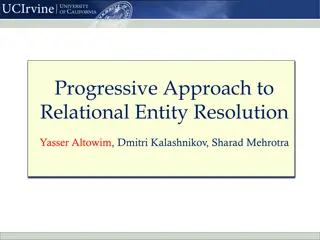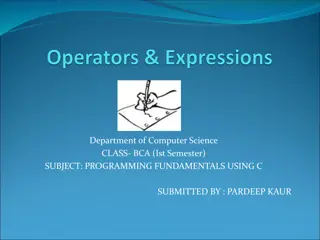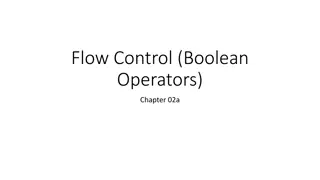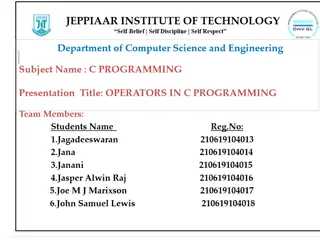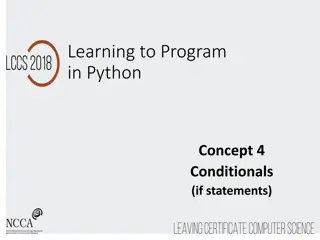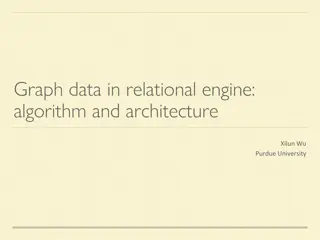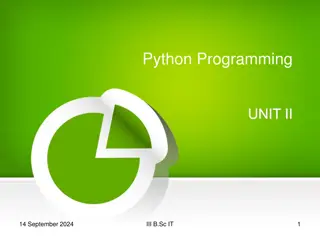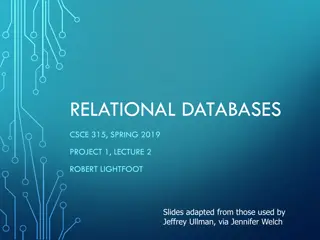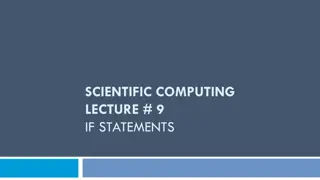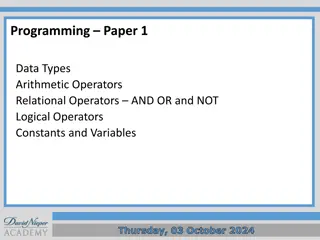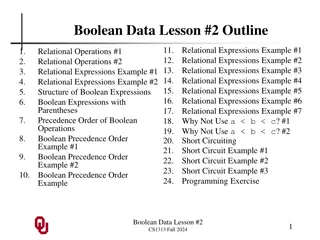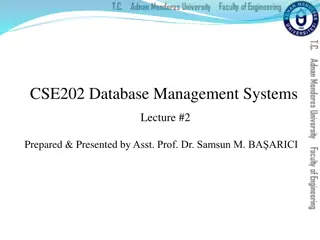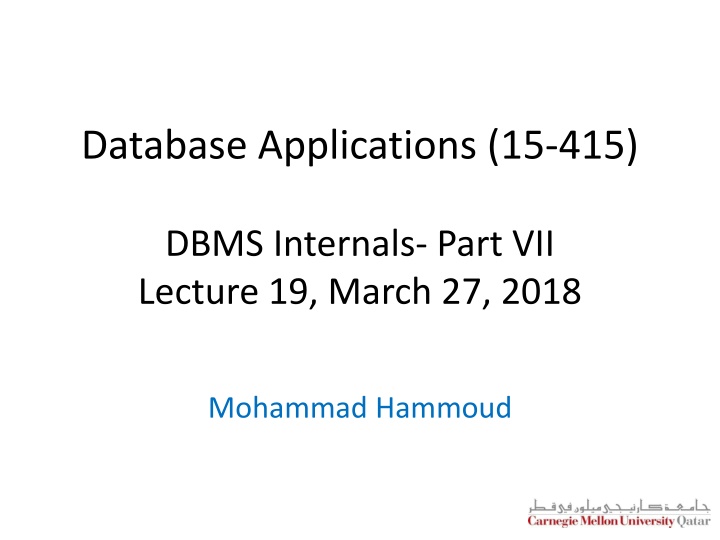
Database Operations and Optimization Techniques
Explore the intricacies of database operations and optimization techniques, including algorithms for relational operations, query execution, and access methods. Learn about key concepts such as selection, projection, and joining to enhance your understanding of database management systems internals.
Download Presentation

Please find below an Image/Link to download the presentation.
The content on the website is provided AS IS for your information and personal use only. It may not be sold, licensed, or shared on other websites without obtaining consent from the author. If you encounter any issues during the download, it is possible that the publisher has removed the file from their server.
You are allowed to download the files provided on this website for personal or commercial use, subject to the condition that they are used lawfully. All files are the property of their respective owners.
The content on the website is provided AS IS for your information and personal use only. It may not be sold, licensed, or shared on other websites without obtaining consent from the author.
E N D
Presentation Transcript
Database Applications (15-415) DBMS Internals- Part VII Lecture 19, March 27, 2018 Mohammad Hammoud
Today Last Session: DBMS Internals- Part VI Algorithms for Relational Operations Today s Session: DBMS Internals- Part VII Algorithms for Relational Operations (Cont d) Announcements: P3 is due on Apr 15
DBMS Layers Queries Query Optimization and Execution Relational Operators Files and Access Methods Transaction Manager Recovery Manager Buffer Management Lock Manager Disk Space Management DB
Outline Introduction Done! The Selection Operation The Projection Operation The Join Operation
Assumptions We assume the following two relations: Sailors (sid: integer, sname: string, rating: integer, age: real) Reserves (sid: integer, bid: integer, day: date, rname: string) For Reserves, we assume: Each tuple is 40 bytes long, 100 tuples per page, 1000 pages For Sailors, we assume: Each tuple is 50 bytes long, 80 tuples per page, 500 pages Our cost metric is the number of I/Os We ignore the computational and output costs
The Projection Operation Consider the following query, Q, which implies a projection: SELECTDISTINCT R.sid, R.bid FROM Reserves R How can we evaluate Q? Scan R and remove unwanted attributes (STEP 1) Eliminate any duplicate tuples (STEP 2) STEP2 is difficult and can be pursued using two basic approaches: Projection Based on Sorting Projection Based on Hashing
The Projection Operation Discussions on: Projection Based on Sorting Projection Based on Hashing
Projection Based on Sorting The approach based on sorting has the following steps: Step 1: Scan R and produce a set of tuples, S, which contains only the wanted attributes Step 2: Sort S using external sorting Step 3: Scan the sorted result, compare adjacent tuples, and discard duplicates What is the I/O cost (assuming we use temporary relations)? Step 1: M + T I/Os, where M is the number of pages of R and T is the number of pages of the temporary relation Step 2: 2T # of passes I/Os Step 3: T I/Os
The Projection Operation: An Example Consider Q again: SELECTDISTINCT R.sid, R.bid FROM Reserves R How many I/Os would evaluating Q incur? Step 1: M + T = 1000 I/Os + 250 I/Os, assuming each tuple written in the temporary relation is 10 bytes long Step 2: if B (say) is 20, we can sort the temporary relation in 2 passes at a cost of 2 250 2 = 1000 I/Os Step 3: add another 250 I/Os for the scan Total = 2500 I/Os
B-Way Merge Sort How can we sort a file with N pages using B buffer pages? Pass 0: use B buffer pages and sort internally This will produce sorted B-page runs Passes 1, 2, : use B 1 buffer pages for input and the remaining page for output; do (B-1)-way merge in each run / N B INPUT 1 . . . . . . INPUT 2 . . . OUTPUT INPUT B-1 Disk Disk B Main memory buffers
B-Way Merge Sort: I/O Cost Analysis + 1 log / N B Number of passes = 1 B For our example (i.e., 250 pages), using 20 buffer pages Number of passes = 1 + log(20-1) 250/20 = 2
The Projection Operation: An Example Consider Q again: SELECTDISTINCT R.sid, R.bid FROM Reserves R How many I/Os would evaluating Q incur? Step 1: M + T = 1000 I/Os + 250 I/Os, assuming each tuple written in the temporary relation is 10 bytes long Step 2: if B (say) is 20, we can sort the temporary relation in 2 passes at a cost of 2 250 2 = 1000 I/Os Step 3: add another 250 I/Os for the scan Total = 2500 I/Os Can we do better?
Projection Based on Modified External Sorting Projection based on sorting can be simply done by modifying the external sorting algorithm How can this be achieved? Pass 0: Project out unwanted attributes Passes 1, 2, 3, etc.: Eliminate duplicates during merging What is the I/O cost? Pass 0: M + T I/Os Passes 1, 2, 3, etc.: Cost of merging
Projection Based on Modified External Sorting: An Example Consider Q again: SELECT DISTINCT R.sid, R.bid FROM Reserves R How many I/Os would evaluating Q incur? Pass 0: M + T = 1000 + 250 I/Os Pass 1: read the runs (total of 250 pages) and merge them Grand Total = 1500 I/Os (as opposed to 2500 I/Os using the unmodified version!)
The Projection Operation Discussions on: Projection Based on Sorting Projection Based on Hashing
Projection Based on Hashing The algorithm based on hashing has two phases: Partitioning Phase Duplicate Elimination Phase Partitioning Phase (assuming B buffers): Read R using 1 input buffer, one page at a time For each tuple in the input page Discard unwanted fields Apply hash function h1 to choose one of B-1 output buffers
Projection Based on Hashing The algorithm based on hashing has two phases: Partitioning Phase Duplicate Elimination Phase Two tuples that belong to different partitions are guaranteed not to be duplicates Partitioning Phase: Original Relation Partitions OUTPUT 1 1 2 INPUT 2 hash function h1 . . . B-1 B-1 B main memory buffers Disk Disk
Projection Based on Hashing The algorithm based on hashing has two phases: Partitioning Phase Duplicate Elimination Phase Duplicate Elimination Phase: Read each partition and build a corresponding in- memory hash table, using hash function h2 (!= h1) on all fields, while discarding duplicates If a partition P does not fit in memory, apply hash-based projection algorithm recursively on P
Projection Based on Hashing The algorithm based on hashing has two phases: Partitioning Phase Duplicate Elimination Phase What is the I/O cost of hash-based projection? Partitioning phase = M (to read R) + T (to write out the projected tuples) I/Os Duplicate Elimination phase = T (to read in every partition) (CPU and final writing costs are ignored) Total Cost = M + 2T
Projection Based on Hashing: An Example Consider Q again: SELECT DISTINCT R.sid, R.bid FROM Reserves R How many I/Os would evaluating Q incur? Partitioning phase: M + T = 1000 + 250 I/Os Duplicate Elimination phase: T = 250 I/Os Total = 1500 I/Os (as opposed to 2500 I/Os and 1500 I/Os using projection based on sorting and projection based on modified external sorting, respectively) Which one is better, projection based on modified external sorting or projection based on hashing?
Sorting vs. Hashing The sorting-based approach is superior if: The duplicate frequency is high Or the distribution of (hash) values is very skewed With the sorting-based approach the result is sorted! Most DBMSs incorporate a sorting utility, which can be used to implement projection relatively easy Hence, sorting is the standard approach for projection!
Index-Only Scan Can an index be used for projections? Useful if the key includes all wanted attributes As such, key values can be simply retrieved from the index without ever accessing the actual relation! This technique is referred to as index-only scan If an ordered (i.e., tree) index contains all wanted attributes as prefix of search key, we can: Retrieve index entries in order (index-only scan) Discard unwanted fields and compare adjacent tuples to eliminate duplicates
Outline Introduction The Selection Operation The Projection Operation The Join Operation
The Join Operation Consider the following query, Q, which implies a join: SELECT * FROM Reserves R, Sailors S WHERE R.sid = S.sid How can we evaluate Q? Compute R S Select (and project) as required But, the result of a cross-product is typically much larger than the result of a join Hence, it is very important to implement joins without materializing the underlying cross-product
The Join Operation We will study five join algorithms, two of which enumerate the cross-product and three which do not Join algorithms which enumerate the cross-product: Simple Nested Loops Join Block Nested Loops Join Join algorithms which do not enumerate the cross-product: Index Nested Loops Join Sort-Merge Join Hash Join
Assumptions We assume equality joins with: R representing Reserves and S representing Sailors M pages in R, pR tuples per page, m tuples total N pages in S, pS tuples per page, n tuples total We ignore the output and computational costs
The Join Operation We will study five join algorithms, two of which enumerate the cross-product and three which do not Join algorithms which enumerate the cross-product: Simple Nested Loops Join Block Nested Loops Join Join algorithms which do not enumerate the cross-product: Index Nested Loops Join Sort-Merge Join Hash Join
Simple Nested Loops Join Algorithm #0: (naive) nested loop (SLOW!) R(A,..) S(A, ......) m n
Simple Nested Loops Join Algorithm #0: (naive) nested loop (SLOW!) for each tuple r of R for each tuple s of S if match: print (r, s) R(A,..) S(A, ......) m n
Simple Nested Loops Join Algorithm #0: (naive) nested loop (SLOW!) Outer Relation Inner Relation for each tuple r of R for each tuple s of S if match: print (r, s) R(A,..) S(A, ......) m n
Simple Nested Loops Join Algorithm #0: (naive) nested loop (SLOW!) How many disk accesses ( M and N are the numbers of pages for R and S )? R(A,..) S(A, ......) m n
Simple Nested Loops Join Algorithm #0: (naive) nested loop (SLOW!) How many disk accesses ( M and N are the numbers of pages for R and S )? I/O Cost = M+m*N R(A,..) S(A, ......) m n
Simple Nested Loops Join Algorithm #0: (naive) nested loop (SLOW!) - Cost = M + (pR * M) * N = 1000 + 100*1000*500 I/Os - At 10ms/IO, total = ~6 days (!) I/O Cost = M+m*N R(A,..) S(A, ......) m n Can we do better?
Nested Loops Join: A Simple Refinement Algorithm: Read in a page of R Read in a page of S Print matching tuples COST= ? R(A,..) S(A, ......) M pages, N pages, m tuples n tuples
Nested Loops Join: A Simple Refinement Algorithm: Read in a page of R Read in a page of S Print matching tuples COST= M+M*N R(A,..) S(A, ......) M pages, N pages, m tuples n tuples
Nested Loops Join Which relation should be the outer? COST= M+M*N R(A,..) S(A, ......) M pages, N pages, m tuples n tuples
Nested Loops Join Which relation should be the outer? A: The smaller (page-wise) COST= M+M*N R(A,..) S(A, ......) M pages, N pages, m tuples n tuples
Nested Loops Join M=1000, N=500 - if larger is the outer: Cost = 1000 + 1000*500 = 501,000 = 5010 sec (~ 1.4h) COST= M+M*N R(A,..) S(A, ......) M pages, N pages, m tuples n tuples
Nested Loops Join M=1000, N=500 - if smaller is the outer: Cost = 500 + 1000*500 = 500,500 = 5005 sec (~ 1.4h) COST= N+M*N R(A,..) S(A, ......) M pages, N pages, m tuples n tuples
Summary: Simple Nested Loops Join What if we do not apply the page-oriented refinement? Cost = M+ (pR * M) * N = 1000 + 100*1000*500 I/Os At 10ms/IO, total = ~6 days (!) What if we apply the page-oriented refinement? Cost = M * N + M = 1000*500+1000 I/Os At 10ms/IO, total = 1.4 hours (!) What if the smaller relation is the outer? Slightly better
The Join Operation We will study five join algorithms, two of which enumerate the cross-product and three which do not Join algorithms which enumerate the cross-product: Simple Nested Loops Join Block Nested Loops Join Join algorithms which do not enumerate the cross-product: Index Nested Loops Join Sort-Merge Join Hash Join
Block Nested Loops What if we have Bbuffer pages available? R(A,..) S(A, ......) M pages, N pages, m tuples n tuples
Block Nested Loops What if we have B buffer pages available? A: Give B 1 buffer pages to outer and 1 page to inner R(A,..) S(A, ......) M pages, N pages, m tuples n tuples
Block Nested Loops Algorithm: Read in B 1 pages of R Read in a page of S Print matching tuples COST= ? R(A,..) S(A, ......) M pages, N pages, m tuples n tuples
Block Nested Loops Algorithm: Read in B 1 pages of R Read in a page of S Print matching tuples COST= M+ M/(B 1) *N R(A,..) S(A, ......) M pages, N pages, m tuples n tuples
Block Nested Loops If the smallest (outer) relation fits in memory? That is, M = B 1 Cost =? R(A,..) S(A, ......) M pages, N pages, m tuples n tuples
Block Nested Loops If the smallest (outer) relation fits in memory? That is, M = B 1 Cost = N+M (minimum!) R(A,..) S(A, ......) M pages, N pages, m tuples n tuples
Nested Loops - Guidelines Pick as outer the smallest table (= fewest pages) Fit as much of it in memory as possible Loop over the inner
The Join Operation We will study five join algorithms, two of which enumerate the cross-product and three which do not Join algorithms which enumerate the cross-product: Simple Nested Loops Join Block Nested Loops Join Join algorithms which do not enumerate the cross-product: Index Nested Loops Join Sort-Merge Join Hash Join
Index Nested Loops Join What if there is an index on one of the relations on the join attribute(s)? A: Leverage the index by making the indexed relation inner R(A,..) S(A, ......) M pages, N pages, m tuples n tuples 50

